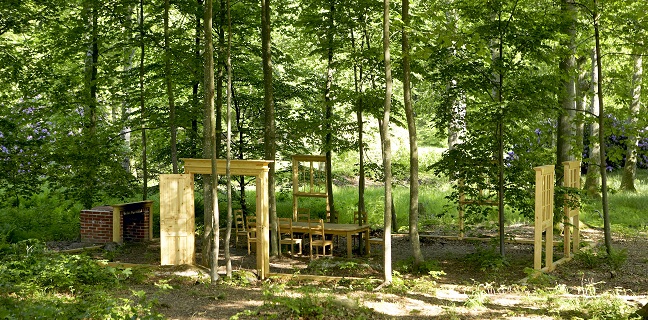
Melissa Martin
(Född/Born 1975, verksam i/works in New York)
Dining Room, 2006
Trä, tegel, betong/Wood, bricks, concrete
Varierande mått/Dimensions variable
For English please scroll down
Dining Room är en kopia av en matsal på Wanås slott, Melissa Martins variant är ett rum i skogen utan väggar och tak, men med fönster och dörrar som markerar rummets dimensioner och ett bord, stolar och en öppen spis. Golvet är skogens och från det växer träd rakt genom möblemanget.
När Dining Room stod färdigt lät konstnären duka upp två traditionella måltider på bordet. En amerikansk Thanksgiving-middag lagades av familjen Martin medan familjen Wachtmeister, som är bosatt i Wanås slott, lagade en svensk julmåltid. I stället för att äta måltiderna brändes de upp tillsammans med dukar och porslin i den öppna spisen. Likt rester av kroppar samlades sedan askan ihop och hälldes i två urnor, som nu ingår i Wanås Konsts samling. Martin gjorde verken till utställningen WANÅS 2006: Insight Out. På utställningens vernissage genomförde hon ytterligare en performance, Embedded. Iklädd kamouflagedräkt, av ett tygtryck baserat på ett foto av marken, lade hon sig bland vitsipporna i parken med munnen full av de giftiga liljekonvaljer som hon själv drivit upp med hjälp av sina kroppsvätskor.
Ett genomgående tema i Martins konstnärskap är relationen mellan den mänskliga kroppen och sociala riter, såsom att äta tillsammans. I Dining Room kopplar hon samman den traditionella högtidsmåltiden med traditionen att bränna föda och föremål.
>>>
Dining Room is a copy of a dining room at Wanås Castle. Martin’s variation is a room in the forest. It lacks walls or a ceiling but includes windows and doors marking the room’s dimensions, as well as a table, chairs, and fireplace. The forest provides the floor, and from it, trees grow right through the furniture.
When Dining Room was finished, the artist had the table set for two traditional meals. The Martin family prepared an American Thanksgiving dinner, while the Wachtmeister family, who lives in Wanås Castle, prepared a Swedish Christmas dinner. Instead of being eaten, however, the dinners were burned in the fireplace along with the table linens and the china. The ashes were then gathered like the remains of cremated bodies and put into two urns that are now part of Wanås Konst’s collection. Martin created the works for the exhibition WANÅS 2006: Insight Out. For the exhibition’s opening, she carried out yet another performance, Embedded. Dressed in camouflage made of fabric, custom-printed from a photograph of the ground, she laid down among the wood anemone in the Park with her mouth full of poisonous Lily of the Valley flowers that she had grown using her own bodily fluids.
An ongoing theme in Martin’s art is the relationship between the human body and social rituals, such as eating together. In Dining Room, she connects traditional holiday meals with the tradition of incinerating food and objects.